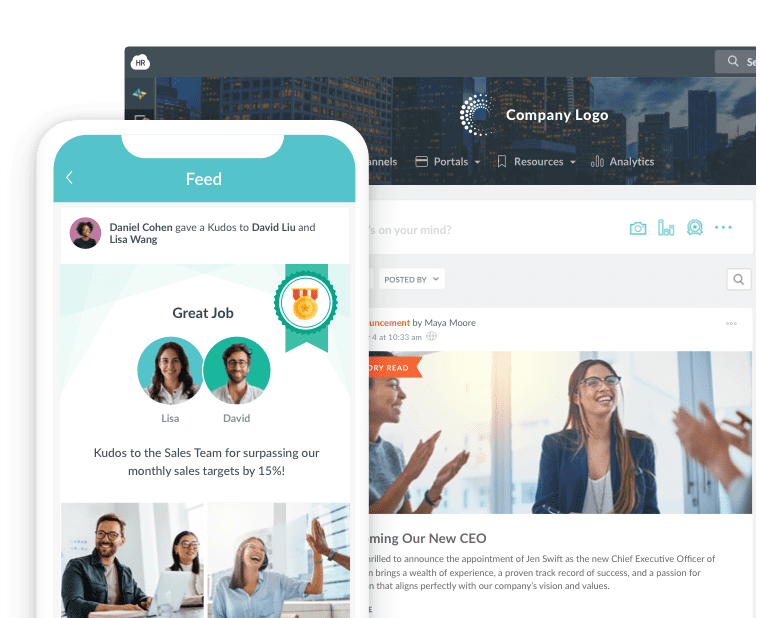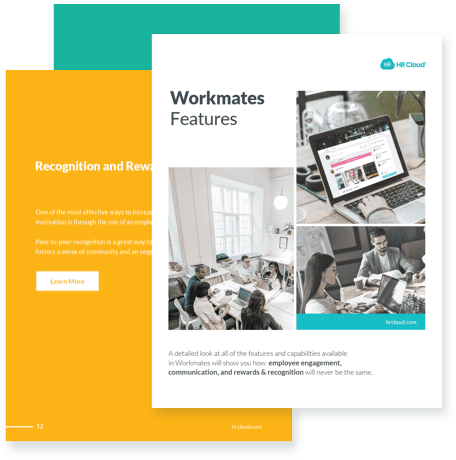As technology continues to advance, some people may think intranets are a thing of the past, but they are entirely relevant even today.
Whether it is a website, a platform, or a tool, in this article, we’ll explain just what an intranet is, as well as how it has evolved, its application in modern-day organizations, and its advantages and disadvantages.
Company Intranet Software that Encourages Employee Communication
Drive culture and communication with engaging intranet experience.

Definition of the Intranet
The definition of an intranet, in simple terms, is a private network within your organization that allows secure communication for you and your employees.
It is used for multiple purposes depending on the structure and objectives. It mainly enables an organization to share information at an internal level. This information is inaccessible to outsiders.
History of the intranets
To understand company intranets, we must have a brief look at its history:
Intranet websites first appeared along with the internet in the 1990s, when they were used in the form of a webpage. It was a single welcome page that contained general information about the company. When the intranet site was first introduced, it was flat, filled with text and hyperlinks, and didn’t offer much in terms of search, sharing, or other capabilities.
In the 2000s, Intranets saw developments as the technology was advancing at a rapid pace. A help desk was introduced that helped in human resource functions. It included features like employee directories and other applications that helped them in day-to-day activities.
By the 2010s, platform integration began as social media advanced. Intranet then became a platform that supported two-way communication or “conversations”.
In recent years, the role of social media in intranets has grown significantly. Many social features have been added. These include mentions, comments, and hashtags. The websites can monitor real-time activities and can gain timely insights as user experience is the central focus.
As a result, employee engagement, collaboration, and communication were significantly improved.

 Try Out Our
Try Out OurEmployee Engagement Software For Free


Difference Between Intranet, Internet, and Extranet
A lot of people assume that the internet, intranet, and extranet are the same, but they are actually three different types of networks. It’s important for those in human resources (HR) to know the differences between them so they can understand the business uses and security implications of each system.
From a technological perspective the intranet, internet, and extranet are very similar, but what sets them apart is who can access them (privacy access) and what they aim to achieve.
An Internet is a network that is available to everyone, while intranets are private networks designed for specific groups of people. An extranet is also a private network but as an extension of an intranet that allows controlled access to authorized external users, such as customers, suppliers, or business partners.
Let’s break down the 3 nets and show some examples:
Intranet:
A company like Google uses an intranet called "MOMA" for internal communications, document sharing, and project management. Only employees can access this network, ensuring that sensitive information remains secure and internal operations run smoothly.
Extranet:
Walmart uses an extranet called "Retail Link" to share inventory and sales data with suppliers. This allows suppliers to manage their products more effectively and respond to demand changes, while Walmart retains control over who can access the data.
Internet:
Amazon's website is a prime example of the Internet. It's a public platform where anyone can browse, purchase products, and access services from anywhere in the world, demonstrating the openness and accessibility that characterize the Internet.
What Are Intranets Used For?
Let’s move towards the functionality and features of intranets. Broadly, the use of intranets can be grouped as follows: Communication, collaboration, information, and business processes. These four purposes will then be tailored for the organization according to its objectives and goals.
The list below shows the most common uses:
-
Source of connection: Companies are going global and require a smooth flow of information. An intranet will ensure this by connecting all the employees; hence it helps in building a virtual culture.
-
Access to information: Intranets can be used to access documents, centrally host, and provide information that the employees need urgently and timely.
-
Employee engagement: Intranets are used for onboarding and allocating tasks. They can also be used to gain insights into employee sentiments. In turn, organizations can respond to their concerns.
-
Business objectives: Intranets play a leading role in supporting the strategic objectives of an organization. They help in building a virtual culture, employee engagement, and staff retention rates and ensure a smooth flow of communication.

Popular features of the Intranet
A company’s intranet is considered the base of employee communication. So, you will have to gather the right features to be well-integrated and improve collaboration. Some of the most popular Intranet features are:
-
Event management
-
Dynamic widgets
-
Intuitive search
-
Social tools
-
Personalized content
-
Integration with cloud-based systems
Advantages and disadvantages of intranet
Intranets can revolutionize internal company communication and streamline operations, but they do come with some challenges. On one side, they offer centralized information access and improved collaboration, and on the other, they may face issues like maintenance costs and user adoption hurdles. Understanding both the benefits of intranet as well as challenges is crucial for making an informed decision.
Advantages of Intranet
-
Improved Employee Productivity - It will help you keep your employees and their work aligned with the company culture - values, vision, and mission - while also improving information flow. It leads to faster decision-making processes, which might contribute to increased sales. As an owner, you can also collect vital employee feedback that will help your company grow and thrive. It is essential to create an efficient digital workplace, especially considering the growing popularity of remote work.
-
Easy and Secure Data Storage - It helps you manage all the important data and files, organize them, and store them in one place, which is easily accessible to anyone who needs it. Furthermore, all communications and information exchanges are saved in an intranet, so nothing will get lost. As such, a dedicated intranet can be an excellent alternative to document and content management systems.
-
Improved Employee Experience - Your HR team will be able to onboard new employees more smoothly, leading to increased employee satisfaction. Easy access to company information, better internal communication and collaboration tools, and improved problem-solving processes will also reduce stress and frustration. It might all contribute to your employees’ loyalty and dedication, and as such, to their productivity.
Additionally, an intranet can be a hopeful tool for recognition and rewards, which are both necessary to keep your encouraged employees feeling happy and satisfied.
You can also go for something called social intranet - software designed to focus on emphasizing social networking.

Disadvantages of Intranet
-
Maintenance Costs - To make sure that your intranet is working smoothly and is always up to date, you will probably need someone to oversee it. What’s more, intranets usually require specialists who know all the system’s intricacies, so it can’t be just anyone.
-
Information Overload - Due to digitalization, we are all being bombarded with information every step of the way. Professional life is no exception here. So, if your company already uses a variety of tools you can’t give up, introducing an intranet might only add up to the pile of information your employees need to get through every day.
-
Security Risks - Even though an intranet is a secure private network, a hacker can use social engineering tactics to get inside, especially if your dedicated solution works on old-school platforms and systems. That’s why it’s vital to have an intranet designed to your preferences, needs, and possible risks.
Why Intranets are the heart of the digital workplace
Intranets have evolved and proved to adapt according to the demands of an organization. Their capability to turn a workplace into a virtual culture makes them the heart of the digital workplace. It is crucial to consider the potential that it holds and the role it plays in helping the organization in reaching its objectives.
Traditional intranets with outdated features are of no use to an organization and are becoming obsolete. Modern intranets act as gateways to modern organizations with virtual cultures. So, it is vital to keep them updated and upgraded. Modern features should be added to enhance employee experience, workplace collaboration, and ROI.
Conclusion
The intranet is an important tool for businesses and organizations to improve team productivity, collaboration, and communication within their internal network. Understanding what is intranet and how can intranet benefit your company can help you make informed decisions about implementing or improving your intranet solution. Whether you have an established intranet or are considering implementing one, it's important to regularly review and update it to ensure it remains an effective tool for your team.
About Author:
Christopher Mansfield is a content writer at Perfect Essay. He creates, edits, and manages the production of digital and print content that is consistent with the organization’s brand, style, and tone. Christopher works closely with the internal marketing team to ensure timely delivery of content via various marketing channels and mediums. He also develops and maintains an editorial calendar. He contributes to the webinar program to further thought leadership campaigns for different market segments.
Keep Reading
Balancing Technology and the Human Touch in Employee Engagement
Companies are taking employee engagement very seriously because it is one of the ways of
Building Strong Teams: The Power of Team Bonding Exercises
Never overestimate the power of collaboration as a core element of effective team


